Solar Pump - Umla
![]()
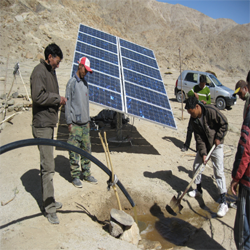 Umla, a small village in the district of Leh, has vast tracts of wastelands. Continuing desertification is reducing the amount of fuelwood and fodder available to sustain the need of even this small population and their livestock. The Pragya intervention sought to use a part of these wastelands for the cultivation of woody species, fodder and medicinal plants, so that the village has resource security and an addition is made to the income of the villagers.
Umla, a small village in the district of Leh, has vast tracts of wastelands. Continuing desertification is reducing the amount of fuelwood and fodder available to sustain the need of even this small population and their livestock. The Pragya intervention sought to use a part of these wastelands for the cultivation of woody species, fodder and medicinal plants, so that the village has resource security and an addition is made to the income of the villagers.
A small stream passing through the village barely meets the requirement of the village before it loses its way in the barren rocky terrain. A submersible pump with a capacity of 900 Watt/3000 litres a day has been installed with 12 PV arrays of 75 Watts each. This pump lifts subsurface water to the wasteland plot to irrigate it. Dug-outs along the infiltration zone facilitate infiltration, recharge aquifers and enhance subsurface flows. Sowing in the wasteland is done in a staggered fashion to ensure continued returns from the wasteland.
The community members of Umla feel that in the long run the wasteland would not only be a good means of income but would also become a viable source of fuelwood and fodder. There has been complete community participation in the intervention. The wasteland is located at some distance from the village, and so the villagers have created a schedule for routine guarding of the solar pump at the wasteland wherein a few members from the community camps out near the pump every night to watch over the pump. The community plans to construct a zing (large storage tank) for the wasteland in the future, and aim to cultivate vegetables such as potato and onion after area expansion of the wasteland.
Zing in Murtija
![]()
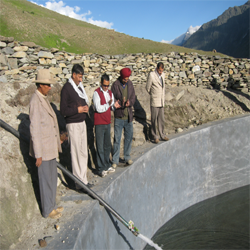 Murtija is a small hamlet in Lahaul valley, with 12 households. The community sought to reclaim a wasteland area that however had no accessible water source. The natural springs available are located a km away from the site. The Pragya intervention has helped construct a zing (large storage tank), thus facilitating storage of water coming from the distant sources.
Murtija is a small hamlet in Lahaul valley, with 12 households. The community sought to reclaim a wasteland area that however had no accessible water source. The natural springs available are located a km away from the site. The Pragya intervention has helped construct a zing (large storage tank), thus facilitating storage of water coming from the distant sources.
The zing measures 225 cubic meters and is cement and poly-lined in order to reduce seepage losses, and is also fitted with a guard-wall for safety considerations. A 1000-meter pipe length was contributed by the Forest Department that helps draw water from the distant springs to the zing. The water feeds the wasteland, which has been stone fenced and planted with Picrorhiza, Angelica, Salix and Populus. The wasteland plantation is benefiting all the households of the village. The zing also serves a nursery and field set up by the Forest Department under its Joint Forest Management scheme.
The community aims to gradually extend the area cultivated thus benefiting more families, and feels that the resource stress would thereby be reduced. The construction of the zing was a remarkable display of community contribution: 50% contribution for the stone fencing around the wasteland came from the community. Moreover, sourcing of the 1000 m pipe for water access from the forest department, supervision of zing construction, and planting of plants and trees were all done by the people themselves. The people were very enthusiastic about the use of the newly constructed zing for irrigating the wasteland and see the cultivation of medicinal plants as a huge gain, especially since the current monoculture of peas and potatoes is not sustainable.
Med-plant Nursery at Stakna
![]()
 The medicinal plants nursery assisted by Pragya at Stakna village of Ladakh promises enhanced income generation for the women in the village.
The medicinal plants nursery assisted by Pragya at Stakna village of Ladakh promises enhanced income generation for the women in the village.
The nursery measures 1200 sq.m. and has been equipped with a trench greenhouse. A women’s group comprising 12 single women (their husbands are in the Army and hence away from home for long periods) manages the nursery. The women have sown seeds of medicinal plants (Inula racemosa, Carum carvi, and Saussurea costus) in the nursery. They aim to use the seeds and saplings generated from the nursery to cultivate the species in their lands so as to reduce harvesting of these species from the wild. This would reduce the time they spend on collecting these species while also saving the material in the wild. They also aim to sell seeds and saplings from the nursery to farmers, since there is increasing awareness of the value of these species.
By the spring of 2009 the nursery had produced Inula saplings that were sold to farmers. The group tries to motivate other community members to adopt this practice by explaining to them the economic value of medicinal plants.
Solar Pump at Chuchot
![]()
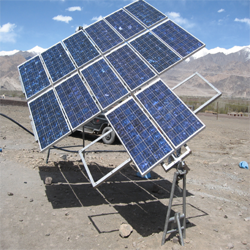 Chuchot, the largest high altitude village on Ladakh plateau, has vast tracts of barren land. A community owned wasteland plot was facilitated by Pragya for conversion to agricultural use. The irrigation technology selected for the purpose was a solar pump to lift subsurface water. The pump has a dynamic head of 170 feet, a solar panel array of 1200 watts and a DC motor, powered by 16 solar photovoltaic modules of 75 watts each, beaming under the desert sun. The multi-stage centrifugal pump with a capacity of 7000 litres per day is being used to irrigate 1.06 ha of land of Chuchot Gongma that has been planted with a mix of medicinal, fodder and fuelwood species. The villagers have drawn up a schedule for irrigating the wasteland wherein they depute two members from each family each day for the same. The wasteland plantation is expected to reduce stress on the forests due to collection of firewood.
Chuchot, the largest high altitude village on Ladakh plateau, has vast tracts of barren land. A community owned wasteland plot was facilitated by Pragya for conversion to agricultural use. The irrigation technology selected for the purpose was a solar pump to lift subsurface water. The pump has a dynamic head of 170 feet, a solar panel array of 1200 watts and a DC motor, powered by 16 solar photovoltaic modules of 75 watts each, beaming under the desert sun. The multi-stage centrifugal pump with a capacity of 7000 litres per day is being used to irrigate 1.06 ha of land of Chuchot Gongma that has been planted with a mix of medicinal, fodder and fuelwood species. The villagers have drawn up a schedule for irrigating the wasteland wherein they depute two members from each family each day for the same. The wasteland plantation is expected to reduce stress on the forests due to collection of firewood.
The people from the village stated that the woody species could also be used for furniture making when they are full-grown in six years time. The pump also serves to provide drinking water to the cold desert neighborhood in the freezing winter months when even the scarce surface water resources are frozen. The villagers feel that the intervention is very fruitful and would help alleviate poverty and stress in the coming years.
Flexible Water Storage Tanks - Kharnak
![]()
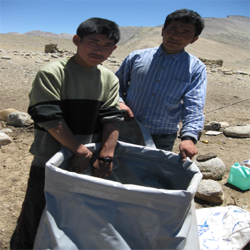 The scenic rangelands of Changthang in Ladakh are characterized by unpredictable, harsh climatic conditions and the livestock-dependent pastoralist inhabitants. The nomadic pastoral community of Kharnak (24 families) migrates throughout the year through six locations in a cyclic manner with their animals, mainly sheep, goats and yaks. It was observed that in three of these locations the source of water was very far off, and the community members expressed the need to address the critical need for water access and storage.
The scenic rangelands of Changthang in Ladakh are characterized by unpredictable, harsh climatic conditions and the livestock-dependent pastoralist inhabitants. The nomadic pastoral community of Kharnak (24 families) migrates throughout the year through six locations in a cyclic manner with their animals, mainly sheep, goats and yaks. It was observed that in three of these locations the source of water was very far off, and the community members expressed the need to address the critical need for water access and storage.
Pragya worked with leading manufacturers in the field to develop flexible water storage tanks for easy transportation while migrating from one halting point to the next. The material for the tanks was selected on the basis of its light weight (to allow easy transportation) and sturdiness of material (to facilitate repeated rough use). 15 such flexible tanks, of 250 liters capacity each, were distributed to the community.
The intervention proved to benefit the people in several ways. First, as a storage facility the tanks reduced the intrinsic drudgery involved with water access. Secondly, the sediments in the water settled down upon storage, thus providing relatively clean water for drinking and cleaning. A third unexpected and rewarding outcome of the intervention was the increased temperature of water in the tanks, which stayed warm when left out in the sun or kept inside the tents and was easier to use.
Snow Reservoir in Demul
![]()
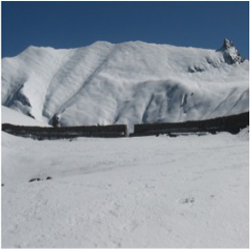 Demul village (4289 m,district Lahaul & Spiti) is located atop a ridge, with an undulating topography and an inhospitable climate (5-months winters with temperatures that go down to -30 degrees C). The 65 households that reside in the village grow subsistence crops in the agricultural lands and also depend on pastoralism. The only source for irrigation is the snowmelt that is accumulated and drawn to the fields through earthen channels. 40% of the village land was however assessed to be wasteland, due to lack of water for irrigation.
Demul village (4289 m,district Lahaul & Spiti) is located atop a ridge, with an undulating topography and an inhospitable climate (5-months winters with temperatures that go down to -30 degrees C). The 65 households that reside in the village grow subsistence crops in the agricultural lands and also depend on pastoralism. The only source for irrigation is the snowmelt that is accumulated and drawn to the fields through earthen channels. 40% of the village land was however assessed to be wasteland, due to lack of water for irrigation.
Pragya constructed a snow reservoir for the Demul community to enable them to harvest the abundant snowfall during winters and harness it for irrigation in the summer. The reservoir is 2 km from the village at an elevation of 4389 m. The bed of the site is plain and flat, with a gentle slope towards the village, and a wall has been erected on this end of the site, thus allowing easy accumulation of snow. The reservoir wall is 59 m long, 2.5 m wide and 2.5 m high. The reservoir will help irrigate approximately 1 sq km of agricultural land and more than 100 people will benefit from the water of this reservoir.
The scarcity of water for irrigation is ameliorated to the extent of 70% through this reservoir. The long-term benefit of the reservoir is recharging of the aquifers with infiltration as a result of the accumulated snow.
Food Godown at Sumdho
![]()
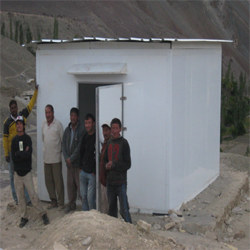 Sumdho, a small semi-nomadic high altitude village in Nyoma Block of Leh district is almost 180 Kms from Leh town, en route the famous Tso Moriri Lake. Located at an altitude of almost 15,000 ft, this village gets only one cropping season, with wheat being the main crop of the village. The village has 53 households with a total population of 230.
Sumdho, a small semi-nomadic high altitude village in Nyoma Block of Leh district is almost 180 Kms from Leh town, en route the famous Tso Moriri Lake. Located at an altitude of almost 15,000 ft, this village gets only one cropping season, with wheat being the main crop of the village. The village has 53 households with a total population of 230.
When the cloudburst hit Leh in August 2010 followed by catastrophic floods, the village had nearly 30% of its households damaged. The ‘community hall’, extensively used for storing food supplies, also developed cracks on the walls and water logging caused severe damage to the food stock. The food godown set up by the State Government also suffered damage as the floodwater entered the building and soaked the food supplies. The subsidized ration received from the government, which included mainly rice, sugar and pulses, was stocked in huge quantities in this godown.
The 10 feet x 12 feet x 8 feet warehouse set up by Pragya much before the floods happened proved to be highly beneficial for the residents of the village in the face of this cataclysmic disaster. The villagers had been using it for storing individual stocks of food grain earlier, but following the floods the warehouse began to be used as a ‘community food reserve’. The warehouse, with a capacity of nearly 5 tonnes, had been designed to withstand such disasters and hence the food supplies in it did not suffer any damage from the floods. The 1 feet high elevated platform of the structure prevented the floodwater from entering and causing any damage. Each warehouse is a moisture-proof and rodent proof structure, specially designed to increase the viability of the food stored inside. The puff panels have the ability to withstand severe weather conditions and the insulation provided by the walls maintains an optimum temperature inside. These lightweight structures can also be transported easily to some other location if need be. The roofs provide better insulation and eliminate leaks. A set of guidelines has also been disseminated amongst the villagers for proper usage and effective management of the food godown.
Mobile Education Units
![]()
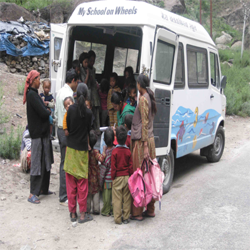 The Mobile Education Unit (MEU) has been a boon to many of the children who could not receive basic education due to various reasons. The MEUs are designed to meet the educational needs of children in various labour camps in the Indian Himalayan Region (IHR), and are equipped with books and teaching aids, learning toys, computers, whiteboards, etc. Earlier these children were living in camps near the construction areas, and did not have a chance to attend school. The number of students in each camp ranges from 8-19. These children are taught for two hours in a day and twice a week. Pragya’s initiative for welfare of road workers’ children started with mobilization and need analysis at these camps followed by design of education modules and training of teachers.
The Mobile Education Unit (MEU) has been a boon to many of the children who could not receive basic education due to various reasons. The MEUs are designed to meet the educational needs of children in various labour camps in the Indian Himalayan Region (IHR), and are equipped with books and teaching aids, learning toys, computers, whiteboards, etc. Earlier these children were living in camps near the construction areas, and did not have a chance to attend school. The number of students in each camp ranges from 8-19. These children are taught for two hours in a day and twice a week. Pragya’s initiative for welfare of road workers’ children started with mobilization and need analysis at these camps followed by design of education modules and training of teachers.
The project has successfully induced interest in the students who earlier never went to school. The various TLMs (Teaching and Learning Materials) designed by educational experts of Jodo Gyan have facilitated basic education through fun and games. In 2010, 22 of these MEU students from Lata and Long camps in Chamoli, Uttarakhand got enrolled in nearby Government primary schools and are now accessing mainstream education.
Empowerment Through Resource Centres
![]()
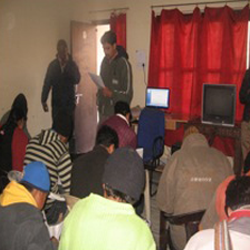 Km. Reena Bhatt is an inspiration to many deprived girls in Chamoli. Reena, who is twenty years of age and whose educational qualification is just tenth standard was the sole earning member of her family. She struggled hard to make both ends meet.
Km. Reena Bhatt is an inspiration to many deprived girls in Chamoli. Reena, who is twenty years of age and whose educational qualification is just tenth standard was the sole earning member of her family. She struggled hard to make both ends meet.
She was hired as the caretaker of the Development Resource Centre (DRC) at Joshimath, and was given the responsibility to look after the centre and conduct its various regular activities. While the computer teacher trained the students on basic computer skills, Reena used to observe keenly. She was sincere and hard working, and grasped all that was taught and very soon was able to utilize what she had learnt. Later she also became a computer trainer in a local computer-training centre near her village. Reena says, ‘I can now earn more because of what I learnt. I hope more girls can follow my footsteps.’
Water Outlets in Kharteng Village
![]()
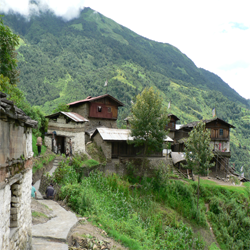 In Kharteng village, which falls under the district of Tawang in Arunachal Pradesh, water distribution was a daunting problem for the entire community. Water was not readily available for the people in this village. The entire village had one water distribution outlet located in a school. This caused two-pronged problems. While one outlet was surely not enough for the whole community, the location of the pipeline meant school proceedings being disturbed every now and then.
In Kharteng village, which falls under the district of Tawang in Arunachal Pradesh, water distribution was a daunting problem for the entire community. Water was not readily available for the people in this village. The entire village had one water distribution outlet located in a school. This caused two-pronged problems. While one outlet was surely not enough for the whole community, the location of the pipeline meant school proceedings being disturbed every now and then.
After the awareness spread by the Barefoot Monitoring System introduced by Pragya, and an application from the village panchayat, the village now has 4 water outlets. The school runs smoothly without any disturbances, and the villagers are now able to easily avail water from sources nearer to their households.
Solar-Wind Hybrid System - Lossar
![]()
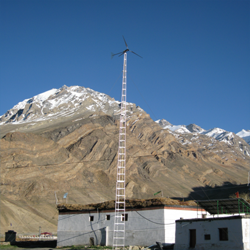 Pragya established a 2.1 KW capacity Solar-Wind Hybrid System (SWHS) in Lossar village of Lahaul & Spiti district (Himachal Pradesh) in the year 2004. The electricity generated by the SWHS is used to serve the households and also the health centre, alternate education centre, and a weaving centre in the village. The installation has brought revolutionary changes in the village especially in terms of education, healthcare and livelihood activities. Villagers are now able to carry out productive activities even in winter season, which was practically unimaginable prior to the installation.
Pragya established a 2.1 KW capacity Solar-Wind Hybrid System (SWHS) in Lossar village of Lahaul & Spiti district (Himachal Pradesh) in the year 2004. The electricity generated by the SWHS is used to serve the households and also the health centre, alternate education centre, and a weaving centre in the village. The installation has brought revolutionary changes in the village especially in terms of education, healthcare and livelihood activities. Villagers are now able to carry out productive activities even in winter season, which was practically unimaginable prior to the installation.
The commitment and response of the community members towards the commissioning of the SWHS was overwhelming. Every member in the village played his or her part in the venture and a sense of ownership was evident. The community members played a vital role despite the time of installation coinciding with the peak agricultural season in the village. People from every household volunteered on a rotational basis. The village council has taken responsibility for management of the SWHS, and has instituted a mechanism for smooth operations. Every household of the village contributes Rs. 500 per year, and funds are also collected for provision of electricity during social/commercial events in the village. The funds collected through these are used for repairs and maintenance of the SWHS, which also demonstrates how the villagers can sustainably manage such facilities and harbour a sense of ownership.
Rural Museum - Dhankar
![]()
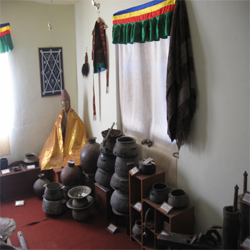 The societies inhabiting the Himalayan region in India have a rich cultural legacy that find material expression in their variegated handicrafts, artefacts of daily use, ornaments, art forms and objects of worship. However, much of this precious legacy is either lost or not available for public gaze.
The societies inhabiting the Himalayan region in India have a rich cultural legacy that find material expression in their variegated handicrafts, artefacts of daily use, ornaments, art forms and objects of worship. However, much of this precious legacy is either lost or not available for public gaze.
Lahaul & Spiti is a high altitude, cold desert district in the Himalayan range just south of Ladakh. Pragya has helped the local communities here to establish a network of Rural Museums, which display the ancient artefacts of cultural interest and value that speak of the history and customs of the Himalayan people. One such Rural Museum is at Dhankar, earlier the capital of Spitian kingdom. The museum is located at the entrance of the nearly 1000 years old Dhankar Gompa (Monastery), dramatically perched on the edge of a sheer precipice overlooking the valley. It houses over 150 artefacts, many of them extinct and threatened. It also provides the community artisans to showcase and sell their cultural products.
Cultural Performers from Ladakh
![]()
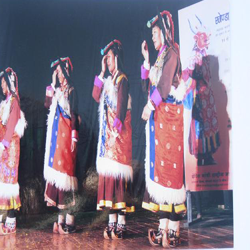 Mr. Tsering Sonam Supari has trained and developed cultural performance troupes, which perform at various events and try to keep the Ladakhi culture alive. He also works towards taking the cultural uniqueness of Ladakh to greater heights by showcasing their vividness at various events. He feels that the youth must adopt the rich culture with the changing times and advent of new technologies. He also feels that the folk culture of music and dance is eroding and government support is crucial for its revival.
Mr. Tsering Sonam Supari has trained and developed cultural performance troupes, which perform at various events and try to keep the Ladakhi culture alive. He also works towards taking the cultural uniqueness of Ladakh to greater heights by showcasing their vividness at various events. He feels that the youth must adopt the rich culture with the changing times and advent of new technologies. He also feels that the folk culture of music and dance is eroding and government support is crucial for its revival.
Last year the troupe headed by Mr. Supari was contacted by the Commonwealth Organizing Committee to organize a group of 75 artists to perform in the CWG opening ceremony. He selected talented children from the remotest villages of Ladakh, who had performed at district or block levels but had not got a bigger platform. As an event Common Wealth Games was one of its kind, and the participation of the young artists was instrumental in motivating and encouraging the youths of the whole region to step forward and promote their rich culture. It was also a very good opportunity for a cross-cultural exchange. During the rehearsals the troupe interacted with artists from all over the nation and learnt about the various cultural forms.
Amchis for Preventive Healthcare Workshops
![]()
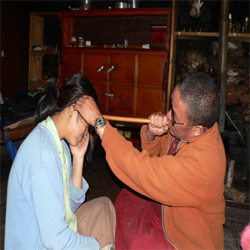 Indigenous communities have rich cultures that are eroding under the onslaught of the homogenising force of modernisation. Apart from the rich heritage of arts & crafts and architecture, what is also being lost is the traditional knowledge of health and medicine, which has evolved over centuries in these indigenous communities. Pragya seeks to tap the traditional knowledge and preserve the culture of indigenous communities. Keeping this in consideration, Pragya is helping in the revival and strengthening of traditional medicine system, and one such system is the Amchi system. After the grassroots workshps and initial support for Amchi system in Ladakh region, Pragya is encouraging them to hold regular healthcare camps in the region for the benefit of the communities and the migrant workers in the region.
Indigenous communities have rich cultures that are eroding under the onslaught of the homogenising force of modernisation. Apart from the rich heritage of arts & crafts and architecture, what is also being lost is the traditional knowledge of health and medicine, which has evolved over centuries in these indigenous communities. Pragya seeks to tap the traditional knowledge and preserve the culture of indigenous communities. Keeping this in consideration, Pragya is helping in the revival and strengthening of traditional medicine system, and one such system is the Amchi system. After the grassroots workshps and initial support for Amchi system in Ladakh region, Pragya is encouraging them to hold regular healthcare camps in the region for the benefit of the communities and the migrant workers in the region.
In one such camp that was held in Leh in 2010, Amchis demonstrated different healthcare measures and also distributed medicines made by using locally cultivated medicinal plants. The people of the area commended the initiative. As the words have spread, more and more people from remote villages are looking forward to such camps to be held in their respective areas.
Traditional Healing Centre - Joshimath
![]()
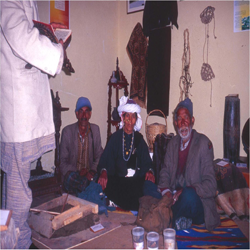 The Himalayan regions have unique and prosperous wealth of medicinal plants and traditional health care systems utilizing this resource. These healthcare systems are eroding rapidly due to ignorance and minimal uses in the region.
The Himalayan regions have unique and prosperous wealth of medicinal plants and traditional health care systems utilizing this resource. These healthcare systems are eroding rapidly due to ignorance and minimal uses in the region.
Pragya is helping the communities in reviving these systems for improved healthcare and livelihoods for the indigenous communities. In this regard, the organization has helped in establishment of Traditional Healing Centres (THCs). The THC at Dhak village, Joshimath is one of these establishments, which is working towards the common good of the people and the practitioners. This centre is managed and run by traditional healers from the region and a lot of people are benefiting from the cost effective services rendered by it. The usage of locally cultivable medicinal plants goes a long way in creating livelihood options for the farmers of the region as well. The centre also holds regular training and demonstration programmes to help new members learn the system and benefit from it.
Improved Road Connectivity - Karchi
![]()
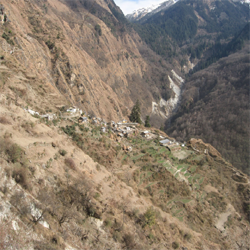 Karchi, a small village in Chamoli district (Uttarakhand) is 3 kilometres trek from the nearest motorable point at Dhak. The road leading to the village was a small trail and quite fragile. Villagers were having problems in commuting to and fro, especially during the nights. During the monsoon, the road used to become even more difficult to use. Children and elders were especially susceptible to injuries due to the fragility of the road.
Karchi, a small village in Chamoli district (Uttarakhand) is 3 kilometres trek from the nearest motorable point at Dhak. The road leading to the village was a small trail and quite fragile. Villagers were having problems in commuting to and fro, especially during the nights. During the monsoon, the road used to become even more difficult to use. Children and elders were especially susceptible to injuries due to the fragility of the road.
Pragya supported CSO - the District-High Himalaya Forum (D-HHF) has been active in high altitude districts, addressing indigenous rights and welfare issues. The issue was discussed among D-HHF members in Chamoli and they approached the District Magistrate of the area in February 2010 for construction of a 3 km road from Dhak to the village. The officials took notice of the gravity of the situation, while the D-HHF members continued their liaison on a regular basis. Due to the pro-activeness of the D-HHF members and support from the administration the construction work has started and the village is now going to have a cement-based road. This would result in easing the problems faced by the villagers and it has also set precedence for other villages for proactive actions.
Mother & Early Childhood Care Centres - Joshimath
![]()
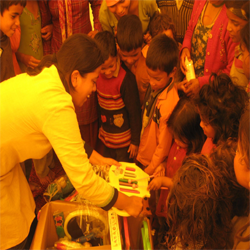 Migrant road & dam workers in the Himalayas live in abject poverty, without access to welfare services and basic human rights, and their Children are among the most disadvantaged in India. Pragya trained road & dam working mothers as 'barefoot creche workers' with inputs on early childhood care and education. Tent-based creches (Mobile Early Childhood Care Centres (MECCC) were established in road workers camps’ for running an infant and child-care programme during the day. The MECCCs are equipped with quality play-way materials. They also provide an alternative for infants and children to being exposed to dust and fumes, and thus ensure prevention of associated diseases.
Migrant road & dam workers in the Himalayas live in abject poverty, without access to welfare services and basic human rights, and their Children are among the most disadvantaged in India. Pragya trained road & dam working mothers as 'barefoot creche workers' with inputs on early childhood care and education. Tent-based creches (Mobile Early Childhood Care Centres (MECCC) were established in road workers camps’ for running an infant and child-care programme during the day. The MECCCs are equipped with quality play-way materials. They also provide an alternative for infants and children to being exposed to dust and fumes, and thus ensure prevention of associated diseases.
The Border Road Organization (BRO) in Joshimath now supports 4 such MECCCs. Lt. Col. Shailendra Grower, BRO, has started this initiative at 4 camps of Suraithota, Lata, Long, and Mallari, setting a good example for sustainability of such development establishments.
Sanitation Facilities for Disaster Victims in Leh
![]()
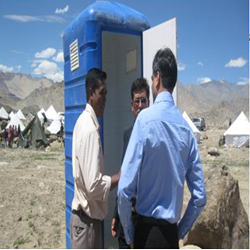 On the evening of 5th August, 2010 Leh and Kargil districts of the Ladakh region of Jammu & Kashmir were hit by torrential rains, owing to a cloudburst that caused an unprecedented loss of life and property in the region. According to the estimates, 80% of the infrastructure in Leh was destroyed including the roads, a large number of households and water sources. The Pragya Team launched into rescue and relief efforts with its field workers based in Leh, and simultaneously began assessing the extent of damage and specific relief requirements.
On the evening of 5th August, 2010 Leh and Kargil districts of the Ladakh region of Jammu & Kashmir were hit by torrential rains, owing to a cloudburst that caused an unprecedented loss of life and property in the region. According to the estimates, 80% of the infrastructure in Leh was destroyed including the roads, a large number of households and water sources. The Pragya Team launched into rescue and relief efforts with its field workers based in Leh, and simultaneously began assessing the extent of damage and specific relief requirements.
Pragya installed 18 portable toilets in 7 different locations covering relief camps at Spituk Angling, Tibetan refugee camp, Chulung, Solar Colony, Mane Tsering, Lingshed hostel at Choglamsar and Degree College, Leh, to ensure that more than 1200 victims of the disaster lived in hygienic and humane conditions. Specifically requested for by the district authorities, these toilets proved to be particularly helpful in addressing the hygiene needs of the women. These toilets were lightweight, and easy to install and relocate. This was supplemented with provision of personal hygiene items including household toiletry kits (2197 numbers) both at the relief camps and also at Saboo, Umla, Stakmo, Shey, Miroo, Nimmo, and Karu villages.
Spring Revitalization at Sakling
![]()
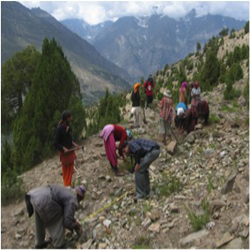 Residents of Sakling village (alt. 3755m) in the district of Lahaul & Spiti are dependent on a spring situated 2 kms above the village for their drinking water needs. Reduced flows as a result of general desertification in the region was a cause of concern for the villagers, and cattle grazing near the mouth of the spring was also leading to impurities in the water and soil slippage as well.
Residents of Sakling village (alt. 3755m) in the district of Lahaul & Spiti are dependent on a spring situated 2 kms above the village for their drinking water needs. Reduced flows as a result of general desertification in the region was a cause of concern for the villagers, and cattle grazing near the mouth of the spring was also leading to impurities in the water and soil slippage as well.
The Domestic Water & Sanitation Committee (DWSC) of Sakling village, which comprises the women of the village, has constructed 20 snow pits of the size of 4 ft. x 3 ft. x 3 ft. at the infiltration zone above the spring site, for recharging the aquifers that feed the spring. The area around the spring has been fenced, and this dissuades cattle from approaching the source and keeps it clean. Women of Sakling have reported a significant improvement in the spring flows since the intervention. The spring water is no longer as muddy as it used to be. 10 households with 57 people are reaping the benefits of the intervention. The people feel that it will bring about a reduction in water-borne diseases due to availability of clean drinking water. The villagers themselves contributed in form of labour for transporting the barbed wire to the spring site located high along the slope and also arranged for the poles for fencing. The people have expressed keen interest in growing more plants near the spring for moisture retention and soil binding.
MPGC Lahaul
![]()
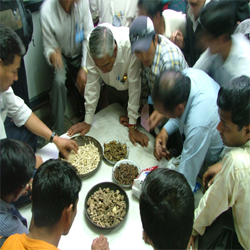 The district of Lahaul-Spiti in the Indian state of Himachal Pradesh consists of the two formerly separate districts of Lahaul and Spiti. It is located at an altitude of 10,050 ft. msl(mean sea level) with close to 35000 people inhabiting the area. The total agricultural area available is barely 3174 ha, which is 0.22% of the total geographical area. The valley has vast tracts of wastelands. The harsh conditions of Lahaul permit only scattered tufts of hardy grasses and shrubs to grow.
The district of Lahaul-Spiti in the Indian state of Himachal Pradesh consists of the two formerly separate districts of Lahaul and Spiti. It is located at an altitude of 10,050 ft. msl(mean sea level) with close to 35000 people inhabiting the area. The total agricultural area available is barely 3174 ha, which is 0.22% of the total geographical area. The valley has vast tracts of wastelands. The harsh conditions of Lahaul permit only scattered tufts of hardy grasses and shrubs to grow.
Pragya conducted initial studies on conservation threats and strengths of local communities in sustainable development of Medicinal and Aromatic Plants (MAP). It also promoted demo-units & herbal gardens for MAP cultivation. Pragya also helped in the formation of Farmer’s Cooperative (The Lahaul Valley Medicinal & Aromatic Plants Growers Cooperative Society Ltd- MPGC) for successful cultivation and sale of MAPs in Lahaul. In 2008 Pragya facilitated Lahaul MPGC for a partnership with Dabur for commercial sales of cultivated MAPs Saussurea, Inula and Aconitum. This has been a major success and farmers are hugely benefited from this partnership by availing higher farm gate prices for their produce, elimination of middlemen, and assured volume uptake and returns. The total sales figure has risen from 26 lakhs in 2008-09 to 45 lakhs in 2010-11, and is expected to touch 87 lakhs in 2012-13. The farmers are now able to manage the activities on their own and more and more farmers are joining MPGC to reap its benefits.